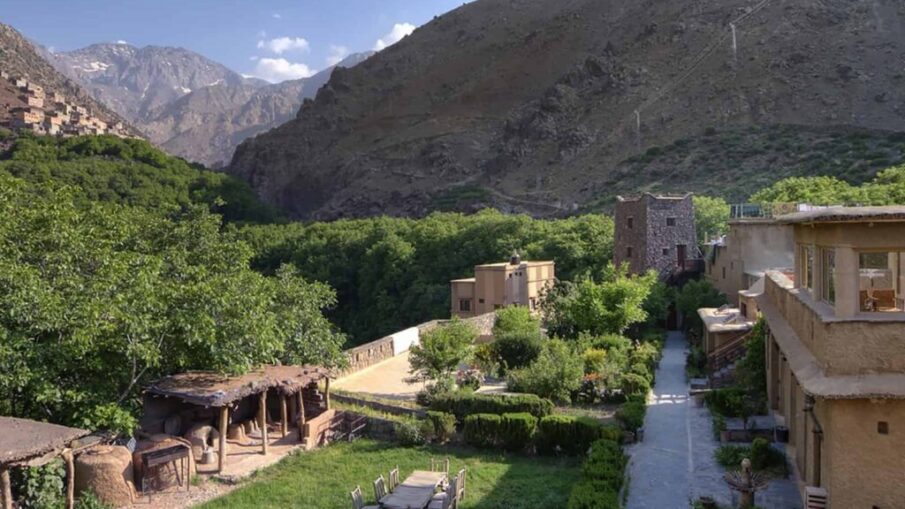Imlil Day Trip From Marrakech: It is estimated that some 100,000 tourists visit Morocco each year with the primary objective of exploring the country’s extensive mountain regions, and with good reason. Upland Morocco offers exceptional beauty, high drama and intruiging cultural encounters in equal measure, and , with an emerging infrastructure to cope with the demands of today’s adventure traveller and a long list of foreign and local tour operators that offer well-organised adventure tours, there’s never been a better time to visit the ‘Land of the Berbers’.
Mountain trekking, characterized by multi-day hiking circuits often incorporating a summit climb, attracts the lion’s share of visitors, although mountain biking, rock climbing and canyoning are growing in popularity. Accessibility and infrastructure tend to dictate which areas draw the most interest, suffice to say that the Toubkal National Park in the High Atlas is by far the most visited region by virtue of its proximity to the tourist Mecca of Marrakesh.
Trekking Practicalities
Times have changed since the first European expedition conquered Jebel Toubkal in 1923. Back then the notion of climbing a mountain for pleasure would have been an alien concept for High Atlas villagers, and although this may still be the case in the remoter regions, the inhabitants of Morocco’s main trailheads have a good understanding of the requirements of the visitor. All of the country’s main hiking regions have a principle village or town where you can engage the services of mountain guides, mules to carry bags, and cooks if required. Some villages have an official guide office (Imlil and Setti Fatma are two examples), but if not, asking around normally yields quick results. In all but the very busiest season you should be able to find a guide available for a departure the following day.
Check the guide’s credentials as the country’s only official mountain guides have completed an extensive training course at Africa’s only mountain guide training college at Tabant in the Ait Bougmez valley. Bone fide guides carry a permit that you can ask to see. Discuss in detail your plans and objectives, agree on a price before setting off, assess the need for a cook and mule(s) to carry your bags and ensure that you are clear on the accommodation and catering situation whilst on trek Casablanca To Chefchaouen. In the absence of any other options, most trekking circuits require you to camp, although certain villages in the High Atlas offer basic lodgings for walkers.
The Club Alpin Français (CAF) operates five refuges in the Toubkal National Park, and some regions are equipped with Gites d’Etape, basic village houses licensed to serve hot meals and provide lodging for tourists. Such houses are important to the rural economy and studies undertaken in areas of the High Atlas suggest that the revenue generated from lodging twenty hikers on a half board basis is equivalent to a year’s revenue from agriculture – a good enough reason in itself for opting to stay in a Gite wherever possible. Also bear in mind the equipment-intensive nature of camping in your trip planning.
Where to go
The most visited of Morocco’s hiking regions is the Toubkal National Park in the High Atlas, home to the country’s highest peak, Jebel Toubkal (4167m/13671ft). Between late spring and early autumn, Toubkal, accessible from the village of Imlil, can be scaled in two days, although many walkers prefer to save North Africa’s highest peak for the climax of a week’s trekking starting from Setti Fatma (in the Ourika Valley) or Oukaimeden. Throughout much of the High Atlas valley walks (as opposed to peaks) offer the best snapshot of rural life, which, in many communities has hardly changed in centuries. The legendary hospitality of the Berber people and the sublime beauty of these villages leaves a lasting imprint on all who visit.
Further to the east, M’goun (4071m/13356 ft), Morocco’s third highest peak, sits in one of the most beautiful parts of the High Atlas. The trailhead valley of Ait Bougmez is home to some of the country’s best-preserved vernacular Berber architecture and offers a hassle-free starting point for five to ten day circuits that scale M’goun. Head for this region during the summer months where temperatures rarely exceed 28°c, a welcome break from the heat of Marrakech, which lies some four hours by road to the west.

